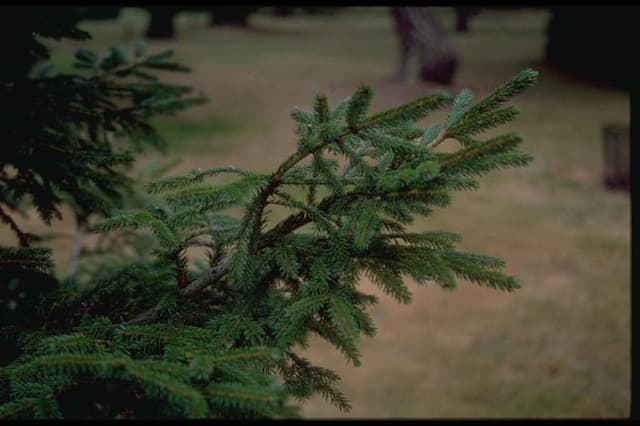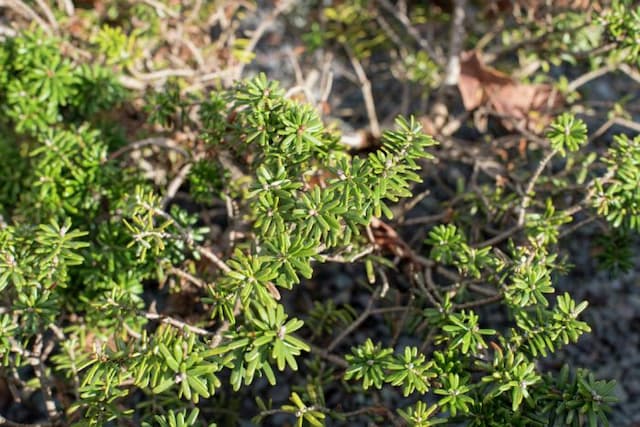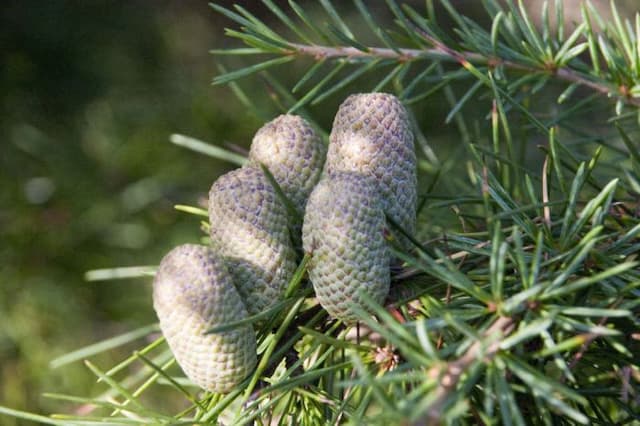Serbian Spruce Picea omorika

ABOUT
The plant commonly known as the Serbian spruce is an evergreen conifer with a graceful and elegant appearance. Characteristically, it has a slender and narrow silhouette, with branches that sweep upwards at the tips, giving it a somewhat airy and delicate look. The needles of the Serbian spruce are short and sharp, displayed in a dense, spiral arrangement around each branch, contributing to its lush texture. They boast a distinct combination of colors: deep, dark green on the upper side with a striking blue-white on the underside, creating a beautiful bi-colored effect that is particularly noticeable when the branches sway in the breeze. As for the cones, they are rather petite and emerge with a purplish hue, maturing to a warm, chestnut brown. The bark is thin with a scaly texture, typically displaying shades of grayish-brown. Overall, the Serbian spruce presents a classic coniferous look with some ornamental features that make it a popular choice for landscaping.
About this plant
 Names
NamesFamily
Pinaceae.
Synonyms
Serbian Spruce, Omorika Spruce.
Common names
Picea omorika var. nana, Picea omorika var. pendula, Picea omorika var. pyramidalis.
 Toxicity
ToxicityTo humans
The Serbian spruce (Picea omorika) is generally not considered toxic to humans. However, ingesting parts of this plant is not advisable due to the potential for irritation or allergic reactions in some individuals. Although toxicity is not a significant concern, consuming any non-food plant can result in digestive discomfort or gastrointestinal upset.
To pets
The Serbian spruce (Picea omorika) is not typically known to be toxic to pets. As with humans, it is not intended for consumption, and eating parts of this plant can cause mild gastrointestinal upset in some animals. It is always best to prevent pets from chewing on or ingesting non-food plants to avoid any potential issues.
 Characteristics
CharacteristicsLife cycle
Perennials
Foliage type
Evergreen
Color of leaves
Green
Height
60 feet (18 meters)
Spread
20 feet (6 meters)
Plant type
Tree
Hardiness zones
4
Native area
Serbia
Benefits
 General Benefits
General Benefits- Ornamental Value: Picea omorika, commonly known as Serbian spruce, is often used in landscaping for its narrow, slender silhouette and graceful form, making it an attractive addition to gardens and parks.
- Durability in Climate Extremes: It is known for its ability to withstand harsh conditions, including cold climates and drought, once established, making it a resilient choice for various environments.
- Wildlife Support: Serbian spruce provides habitat and shelter for birds and other wildlife, establishing a micro-ecosystem where various species can thrive.
- Soil Stabilization: Its root system can help prevent soil erosion, particularly in sloped areas, by holding the ground together with its network of roots.
- Architectural Use: Due to its tall and straight growth habit, it's used in garden design to create vertical accents or as a natural screen for privacy.
- Windbreak: When planted in rows, Serbian spruce can act as an effective windbreak, protecting smaller plants and reducing wind speed in open areas.
- Shade Provider: It can offer a considerable amount of shade in summer due to its dense foliage, creating cooler areas in gardens and parks.
- Seasonal Interest: Provides year-round visual interest with its evergreen needles and, depending on the variety, can showcase different colors such as blue or green.
- Wood Uses: The wood of Picea omorika is utilized for general construction, paper manufacturing, and as a source of timber for various purposes.
 Medical Properties
Medical Properties- Anti-inflammatory: Picea omorika extracts may possess anti-inflammatory properties beneficial for reducing inflammation.
- Antioxidant: The plant contains compounds that can act as antioxidants, helping to mitigate oxidative stress in the body.
- Antimicrobial: Components within Picea omorika might have antimicrobial effects, potentially aiding in the fight against certain bacteria and fungi.
 Air-purifying Qualities
Air-purifying QualitiesThis plant is not specifically known for air purifying qualities.
 Other Uses
Other Uses- Picea omorika, also known as Serbian spruce, can be used in bonsai culture due to its attractive shape and evergreen foliage, allowing enthusiasts to create miniature landscapes.
- The wood of Serbian spruce can be used for making musical instruments like guitars and violins because it has good acoustic properties.
- Its narrow and elegant growth habit makes Serbian spruce an excellent choice for smaller gardens or urban landscapes where space is at a premium.
- The tree can be used as a privacy screen or windbreak in landscaping, owing to its dense foliage and fast-growing nature.
- Serbian spruce needles can be used as a natural dye, providing a range of green shades for textiles.
- The tree is sometimes planted in cemeteries and memorial parks as a symbol of eternal life because of its evergreen nature and dignified appearance.
- Wood shavings and sawdust from Serbian spruce are used in making particle board or as a base material for wood pulp, contributing to the paper manufacturing industry.
- In winter holiday traditions, the branches of Serbian spruce can be incorporated into festive wreaths and garlands for decoration.
- Due to its resistance to cold, the Serbian spruce is valuable for reforestation and landscaping in cooler climates where other species might not thrive.
- Its decorative cones can be used in crafts and as part of naturalistic floral arrangements, particularly in the winter season.
Interesting Facts
 Feng Shui
Feng ShuiThe Serbian Spruce is not used in Feng Shui practice.
 Zodiac Sign Compitability
Zodiac Sign CompitabilityThe Serbian Spruce is not used in astrology practice.
 Plant Symbolism
Plant Symbolism- Resilience: Serbian Spruce (Picea omorika) is known for its ability to survive in harsh climates and poor soil conditions, symbolizing the human ability to persevere through challenges.
- Endurance: The tree's evergreen nature represents enduring and unchanging strength, able to withstand the tests of time.
- Growth: As with many trees, the Serbian Spruce signifies continual growth, both personal and spiritual, stretching upwards towards the sky.
- Peace: The evergreen boughs of the spruce have been used as a symbol of peace and goodwill, especially around the Christmas season when it is commonly used as a Christmas tree.
 Water
WaterThe Serbian spruce should be watered deeply about once or twice a week, depending on weather conditions and soil moisture levels. Ensure that the soil is moist but not waterlogged, providing around 10 to 15 gallons per watering session for mature trees to encourage deep root growth. During hot, dry spells, water may be needed more frequently, while in cooler, wetter periods, less frequent watering is required. Adjust the watering schedule throughout the year, increasing it during periods of drought and reducing it when rainfall is abundant.
 Light
LightThe Serbian spruce thrives in full sun to partial shade. It prefers a location where it can receive at least six hours of direct sunlight daily. Too much shade can lead to sparse foliage and a less vigorous tree, so aim for a sunny spot with some afternoon protection in areas with very hot summers.
 Temperature
TemperatureSerbian spruce can tolerate a wide range of temperatures, from well below 0°F to above 80°F. Ideal growth is achieved in cooler climates with temperatures ranging from 60°F to 75°F during the growing season. This tree is hardy and adapts well to cold winter conditions, but it may struggle in continuously hot climates.
 Pruning
PruningPrune the Serbian spruce to remove any dead or damaged branches or to maintain its shape, ideally in late winter or early spring before new growth starts. This process is often needed only every few years, as the tree naturally maintains a pleasing shape. Pruning can also be performed to thin the crown for increased air and light penetration if necessary.
 Cleaning
CleaningAs needed
 Soil
SoilThe Serbian spruce (Picea omorika) thrives in well-draining, moist soil rich in organic matter with a slightly acidic to neutral pH of 5.5 to 7.0. A good soil mix for this conifer could consist of equal parts garden soil, peat moss, and coarse sand or perlite to ensure proper drainage and aeration.
 Repotting
RepottingSerbian spruce trees, being slow-growers, don't require frequent repotting; young trees may be repotted every 2-3 years, while more mature specimens can be repotted less frequently, such as every 4-5 years, or as necessary if the plant outgrows its container.
 Humidity & Misting
Humidity & MistingSerbian spruce prefers moderate to high humidity levels but is adaptable to various atmospheric conditions; however, it should be protected from extremely dry environments which can cause stress and needle drop.
 Suitable locations
Suitable locationsIndoor
Grow Serbian spruce in cool, bright area with high humidity.
Outdoor
Plant Serbian spruce in sun or partial shade with moist soil.
Hardiness zone
4-7 USDA
 Life cycle
Life cyclePicea omorika, commonly known as Serbian spruce, begins its life as a seed which germinates in late spring or early summer. The seedlings develop into young trees with a characteristic slender form and drooping branches. As they mature, Serbian spruces undergo a phase of rapid vertical growth and begin to establish their conical shape. After reaching maturity at around 30 years, they can produce cones annually—female cones are reddish and erect while male cones are more numerous and hang beneath the branches. Pollination occurs typically in spring, with wind carrying the pollen from the male to the female cones. Mature Serbian spruces can live for several hundred years, continuing to reproduce and contributing to the forest ecosystem until they eventually die, decompose, and return nutrients to the soil.
 Propogation
PropogationPropogation time
Early Spring
The Serbian spruce, scientifically known as Picea omorika, is commonly propagated through seed collection and sowing. The best time for seed propagation is in the autumn following seed maturation or in the spring. When propagating in the spring, seeds require stratification, which is a process of treating them to simulate natural conditions that the seeds would experience through the winter, typically requiring a period of cold. This can be done by mixing the seeds with some moist sand and storing them in a refrigerator at about 34-41 degrees Fahrenheit (1-5 degrees Celsius) for approximately 3-4 weeks. Sow the seeds in well-drained soil in a container and lightly cover them with soil. The container should be kept in a cool location with indirect sunlight. Water the soil adequately to keep it moist but not waterlogged. Once the seedlings are strong enough and frost danger has passed, they can be transplanted outdoors.









